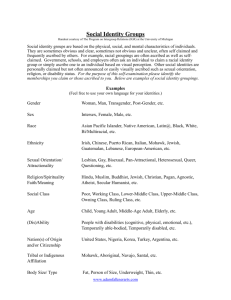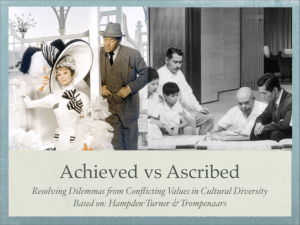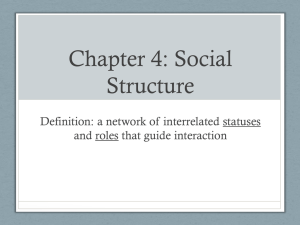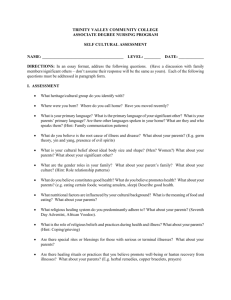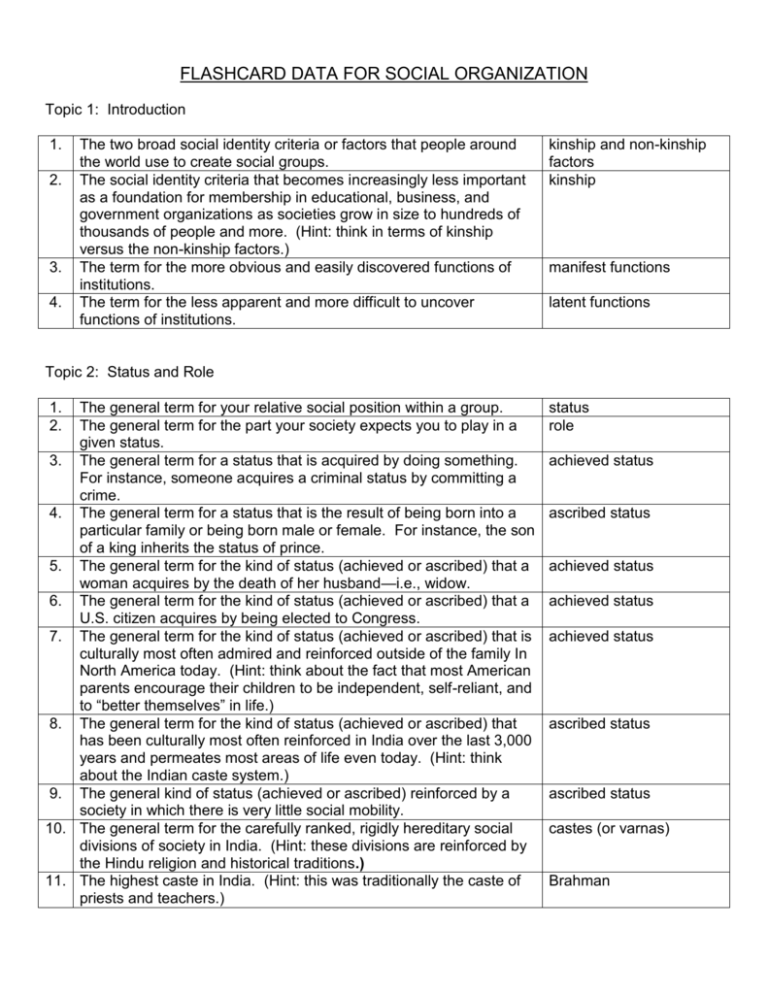
FLASHCARD DATA FOR SOCIAL ORGANIZATION
Topic 1: Introduction
1.
2.
3.
4.
The two broad social identity criteria or factors that people around
the world use to create social groups.
The social identity criteria that becomes increasingly less important
as a foundation for membership in educational, business, and
government organizations as societies grow in size to hundreds of
thousands of people and more. (Hint: think in terms of kinship
versus the non-kinship factors.)
The term for the more obvious and easily discovered functions of
institutions.
The term for the less apparent and more difficult to uncover
functions of institutions.
kinship and non-kinship
factors
kinship
manifest functions
latent functions
Topic 2: Status and Role
1.
2.
The general term for your relative social position within a group.
The general term for the part your society expects you to play in a
given status.
3. The general term for a status that is acquired by doing something.
For instance, someone acquires a criminal status by committing a
crime.
4. The general term for a status that is the result of being born into a
particular family or being born male or female. For instance, the son
of a king inherits the status of prince.
5. The general term for the kind of status (achieved or ascribed) that a
woman acquires by the death of her husband—i.e., widow.
6. The general term for the kind of status (achieved or ascribed) that a
U.S. citizen acquires by being elected to Congress.
7. The general term for the kind of status (achieved or ascribed) that is
culturally most often admired and reinforced outside of the family In
North America today. (Hint: think about the fact that most American
parents encourage their children to be independent, self-reliant, and
to “better themselves” in life.)
8. The general term for the kind of status (achieved or ascribed) that
has been culturally most often reinforced in India over the last 3,000
years and permeates most areas of life even today. (Hint: think
about the Indian caste system.)
9. The general kind of status (achieved or ascribed) reinforced by a
society in which there is very little social mobility.
10. The general term for the carefully ranked, rigidly hereditary social
divisions of society in India. (Hint: these divisions are reinforced by
the Hindu religion and historical traditions.)
11. The highest caste in India. (Hint: this was traditionally the caste of
priests and teachers.)
status
role
achieved status
ascribed status
achieved status
achieved status
achieved status
ascribed status
ascribed status
castes (or varnas)
Brahman
12. The term in India used to refer to people who are below the 4 main
castes in terms of status. (Hint: they are generally considered to be
"polluted" laborers who do the dirtiest, poor paying jobs.)
scheduled castes (also
called untouchables and
Harijan)
Topic 3: Non-kinship Based Social Groups
1.
2.
3.
4.
5.
The general term for age-based categories of people recognized by
a culture. In North America, for example, we generally label people
as children, teenagers, adults, middle aged, and elderly or senior
citizens.
The term for age grades that are clearly recognized in a culture as
distinct identifiable groups of people. They consist of people of
similar age and usually of the same gender who share a common
identity and maintain close ties throughout their lives. They also
pass through age-related statuses together as a group.
The term for a ritual that marks the transition between age-based
statuses or from one phase of life to another.
The region where age sets are especially common.
The region where the cattle herding Masai people live.
6.
The new status that Masai boys acquire at about 12-14 years old.
They are ritually circumcised together in a ritual marking their
transition to this new status.
7. The kinds of societies in which gender-based groups are most likely
to be institutionalized and not mandatory for everyone of the same
gender. (Hint: think in terms of small-scale and large-scale
societies.)
8. The general term for the kind of association that is typified by the
Boy Scouts, Girl Scouts, fraternities, and sororities in North
America.
9. The general term for the kind of association in which membership is
based on vocation, avocation, common residence, religious belief,
political belief, or past experience.
10. The kind of status that membership in voluntary associations is
generally based on in most societies. (Hint: think in terms of
achieved and ascribed status.)
11. The kind of societies in which voluntary associations are least likely
to exist. (Hint: think in terms of small-scale and large-scale
societies.)
Copyright © 2007 by Dennis O'Neil. All rights reserved.
age grades
age sets
rites of passage
Sub-Saharan Africa
East Africa (southern
Kenya and northern
Tanzania)
moran (or warrior)
large-scale societies
gender-based groups
voluntary association
achieved status
small-scale societies

